milkyspit
Flashlight Enthusiast
I've always liked the Gladius in a nerdy sort of way. The switch depresses AND rotates, with three indexed stops and a fourth semi-secret position tucked to one side (a lockout) in the same way reverse is commonly tucked to one side on a manual transmission. This, and the whole thing is magnetically actuated. Even has position-specific tailcap that incorporates a groove for proper alignment. What's a techno geek not to love!?!  :naughty:
:naughty:  oo:
oo:
But I sold my Gladius a long while back, even the nifty tricked-out 'Gladiator' version I'd built for myself with stainless combat bezel and a Luxeon K2-TFFC behind a custom-cut McR27-L reflector. Here's a photo to reminisce:
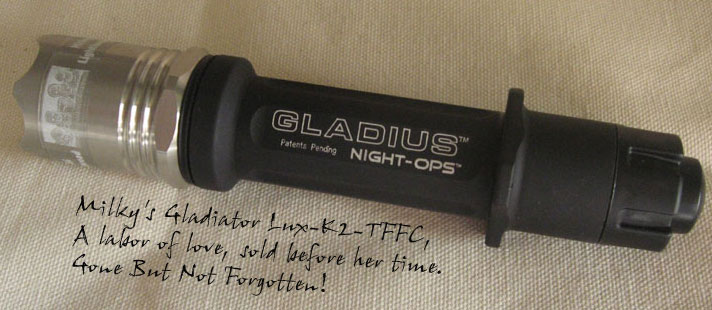
Then the phone rang one fateful day earlier this year. The caller ID said, STRATEGOS INTER. What had I done wrong now!?! Market research firm conducting a survey? (Wasn't I on the do not call list?) Forgot to pay my taxes? Federal agents outside my door, about to burst in and arrest me??
:sweat:
Fortunately, reason got the better of me and I did in fact answer the phone.
What ensued consumed a good chunk of my autumn, for which I'm not complaining in the slightest! I took on a fun project with very satisfying results, and most importantly, I was able to breathe new life into what by all rights is a particularly well-designed light. (Incidentally, Strategos Intl. is, according to my understanding of the history, the co-creator of the original Gladius.)
First off: the upgraded Gladius bears the name Gladius CREEmator. I lent my Creemator name to Strategos per their request. Personally, I would have liked to call it something like Mutant Death Ray but for some reason the marketing folks over at Strategos were looking a little less over-the-top. Anyway, Gladius CREEmator is just as well, in that the upgrade does in fact employ a Cree LED and Milky Labs designed it. Guess that works for me.
Anyway, Gladius CREEmator is just as well, in that the upgrade does in fact employ a Cree LED and Milky Labs designed it. Guess that works for me.
Profile on the Latest High-Tech Milky Photography Scaffolding
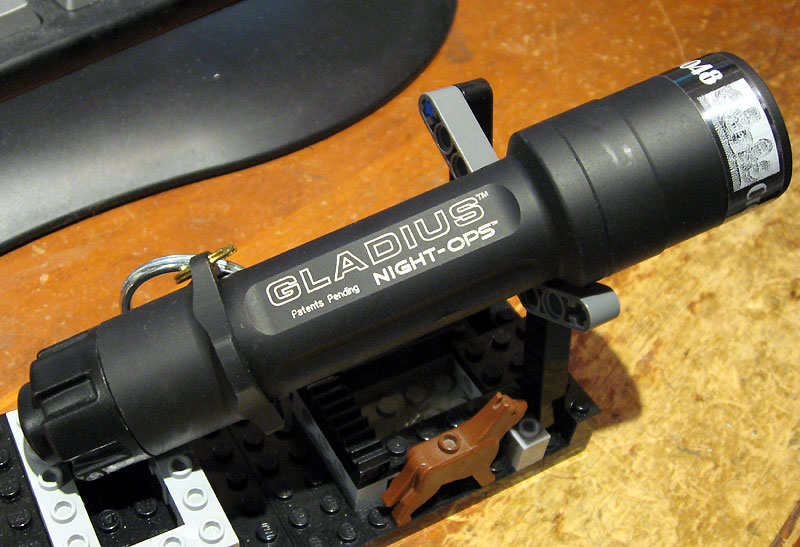
Some CPFers (such as over here) had speculated that a Milkyspit light bearing the CREEmator name must contain an XR-E; that was true when the Creemator was first introduced, as the XR-E was the only high performance Cree available at the time... but is no longer the case, as the XP-E and XP-G, among others, offer additional design options.
Moving Toward the Business End
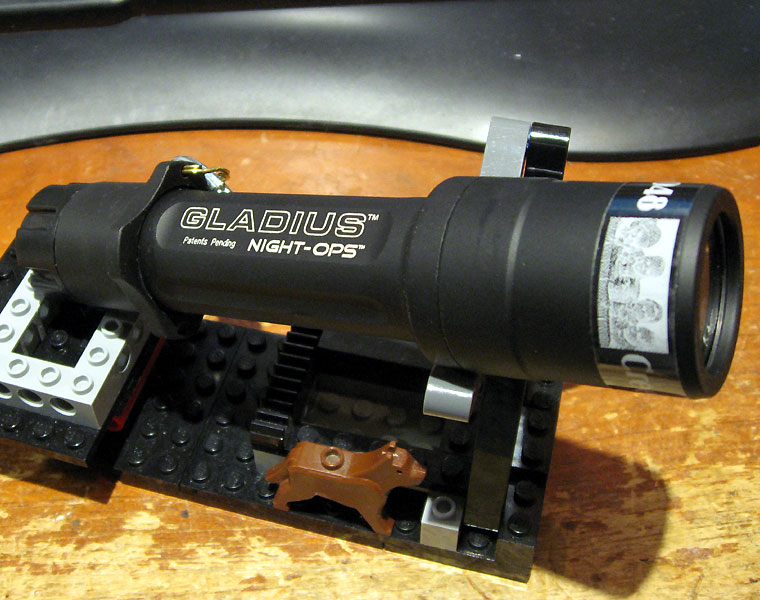
The Gladius as a platform presented some design challenges. First, the upgrade needs to be robust, especially in light of the target market of largely professional law enforcement, search and rescue, military, private security contractors, and similar users. These lights will most definitely NOT be shelf queens.
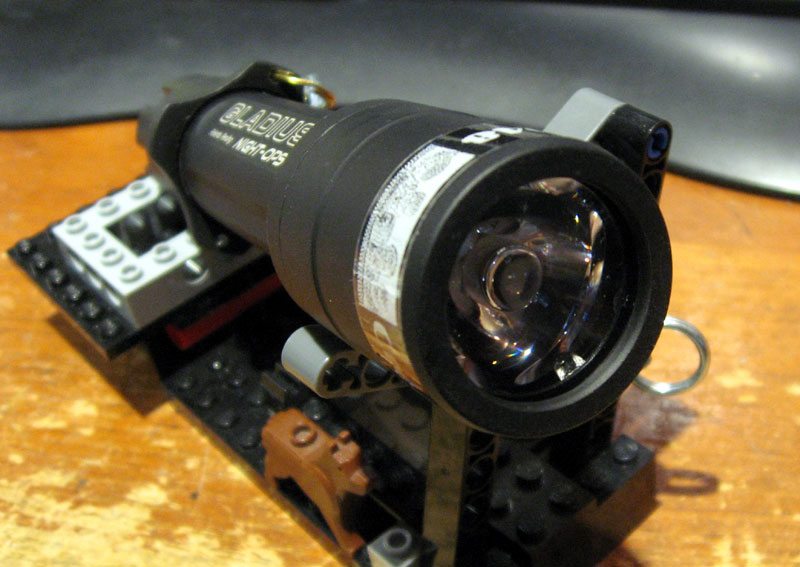
The stock Gladius serrves the professional crowd with subtle touches like a ridiculously thick, AR coated float glass lens. I didn't take a measurement but it stood out to me that this lens is quite possibly the thickest I've ever seen on a light this size... and just in case that's not tough enough, the whole thing sits in a protective sleeve of nylon, form-fit snugly around the glass, to cushion impacts and prevent chips around the edges.
Stock Lens with Blue-Purple AR Coating Visible

For the same reasons, I designed around a reflowed XP-G on large format MCPCB and sourced a very high grade ceramic-impregnated thermal transfer tape for use in the Gladius CREEmator. That ensures that even if one shattered the lens to the point that it fell completely out of the light, the LED would remain firmly attached to its thermal path. The stack is rated to 50-G, and if one's flashlight is subjected to that degree of G-force, one's life will have long since ended, making the flashlight itself somewhat redundant.
Business End Showing the Optic Beneath Stock Lens
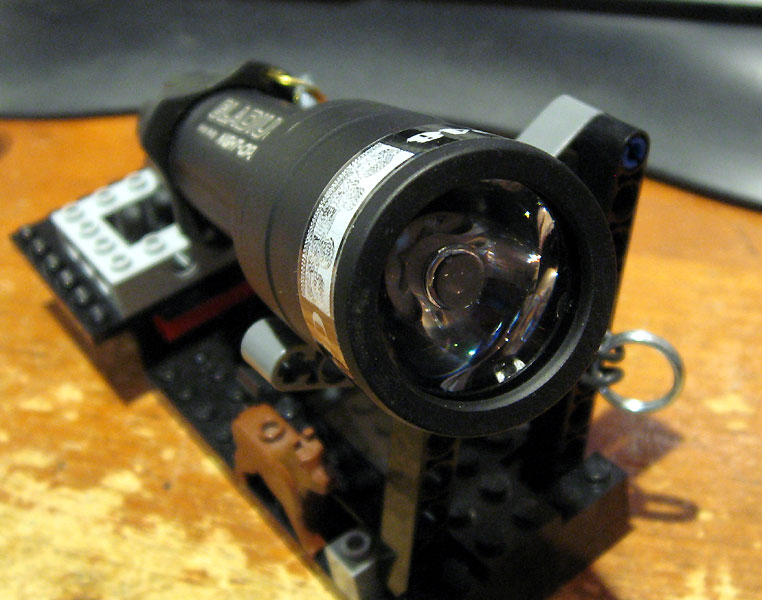
Beyond that, I wanted to improve on the stock light's thermal performance. The previous, Seoul P4-based upgrade tended to pool a lot of heat under the LED, and it's not uncommon to see a Seoul P4 in these lights looking downright abused. That reduces output and may change the tint of the beam as well. Fortunately, I was able to bolster the thermal path in a number of ways. The upgraded light features not only a significantly improved thermal path, but also a much larger capacity for absorbing heat internally, which ought to help matters when operating the light in a less than ideal environment.
The 'Hole' Is an Optical Illusion. The Optic is Actually Solid.
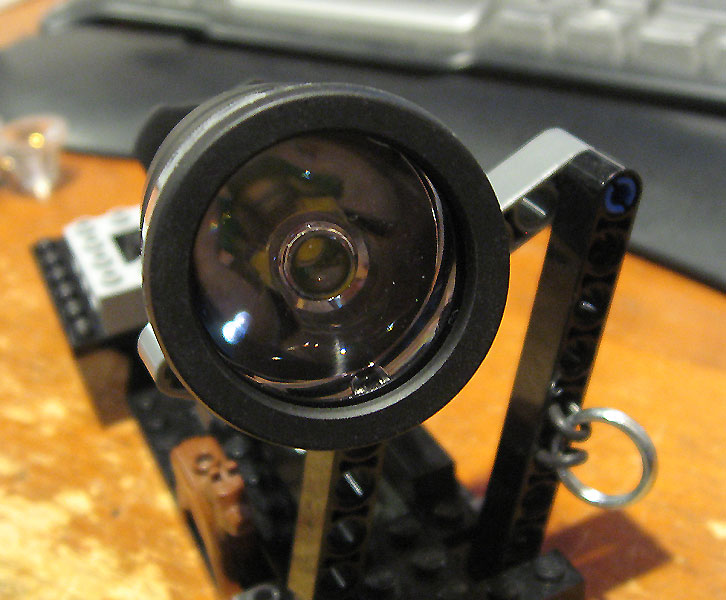
Then there's the beam itself. It would have been fairly easy to design a bright, floody light, but Strategos and their customers were looking for something with much greater punch in the beam's center, accompanied by just enough of a spill beam for a decent context, especially in close quarters use. Toward that end, I employed a largish, 26.5mm optic having beam angle of roughly 8.6 degrees. This compares favorably with the stock light's beam angle of (going from memory) 12 degrees.
Gladius CREEmator Beam Profile
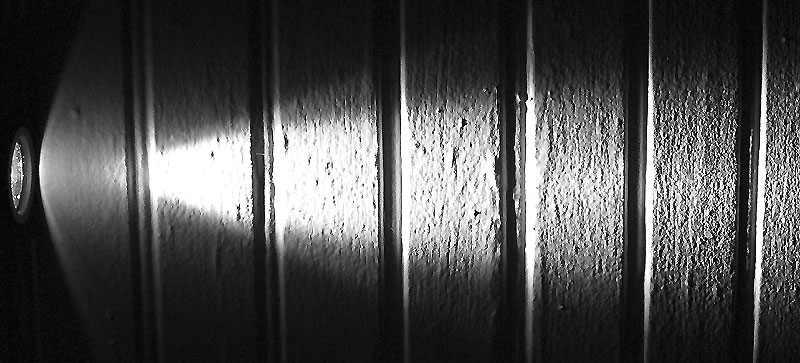
I opted for Cree XP-G over the XP-E, despite the latter's ability to focus more tightly, in the interest of delivering additional lumens as well as greater overall efficiency in terms of lumens per watt. As more brightly binned XP-G enter the marketplace (which I fully expect will happen over the next several months) the XP-G's advantages will only increase. The resulting light delivers a nice performance boost over its predecessors...
Stock Gladius: 60-90 lumens, 1640 lux at 1m
Gladius with Seoul P4: 120-160 lumens, 4280 lux at 1m
Gladius CREEmator (Cree XP-G): 275+ lumens, 8790 lux at 1m
Runtimes are nearly identical with all the above lights. If anything, the XP-G upgrade will slightly increase runtime as the lower Vf of a typical XP-G will result in slightly lower current draw from the cells.
Macro Photo: Camera Face Reflected in Lens! Note Rectangular Stripes Of the XP-G Die at Center

While prototyping, I also created a reflectored equivalent to the above light, but for a variety of reasons, the reflectored design was dropped in favor of the optic. I think that was a good call on Strategos' part. That said, I include the reflectored prototype in the comparison photos that follow in the interest of completeness.
Test #1: Outdoors on a dark night, range approximately 40 yards to the target.
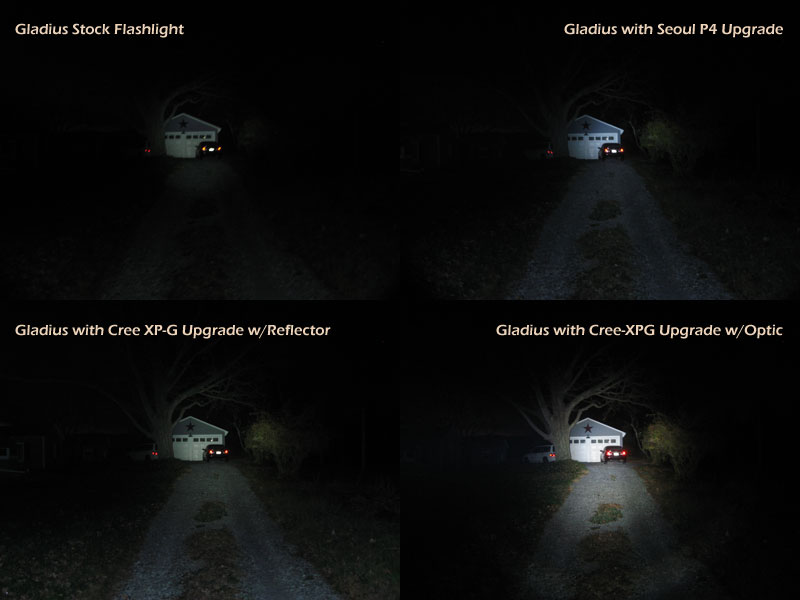
Test #2: Peering into an unfinished basement, distance approximately 15 feet.
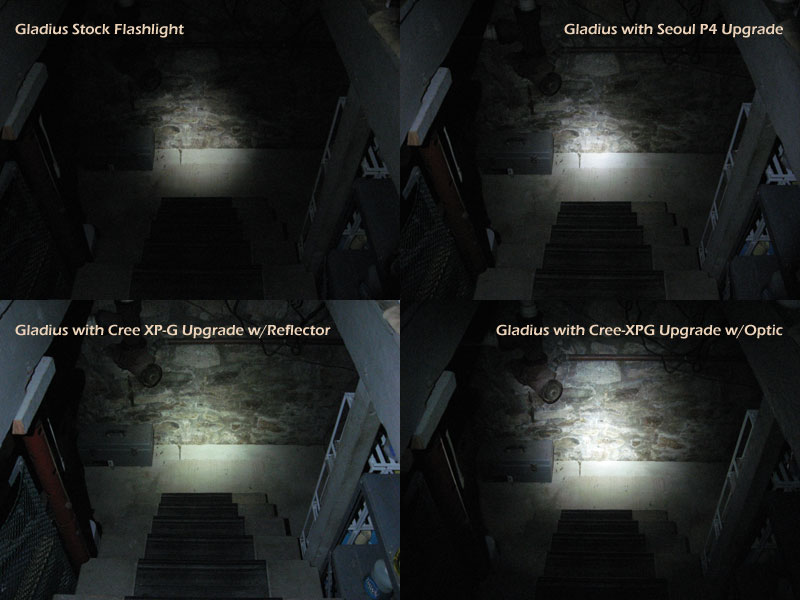
Test #3: Shining across a study into the far right corner, distance approximately 12 feet.
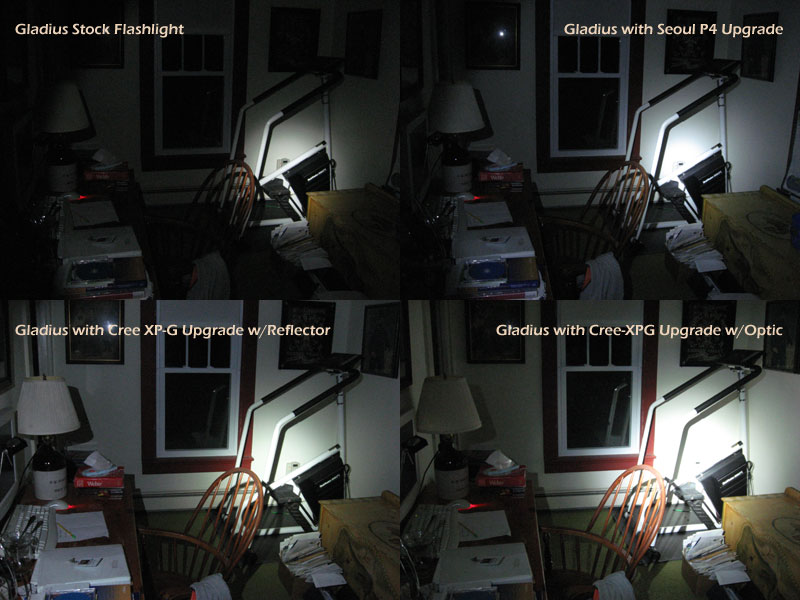
In all the above test scenarios, the reflectored Gladius CREEmator tended to perform about as well as the older, Seoul P4 Gladius upgrade, despite bringing additional lumens to the table. (The added lumens are most noticeable in the sidespill.) The Gladius CREEmator with optic (the design adopted for production) shows a clear advantage in range while still delivering plenty of usable sidespill, even at the closer distances.
If you're read to this point, THANK YOU! :bow: :bow: I realize this is a fairly long writeup. As to the light itself, seems to this point that we're doing well. I did, however, have one lingering question: just how would the upgrade perform in more real world use rather than static comparison tests? Toward that end, I tried shining the light around the house, running the risk of alienating my wife and children in the process. I wanted to see how much of a difference the Gladius CREEmator would make in quickly identifying a person tucked away in the scene.
Shining across the Milky Lab (roughly 20 feet), one of my sons is visible even in ambient light, using the computer at the lower left of the frame. (Note the tiny hand on the mouse just to the left of the Macintosh G4 Cube computer.) Even so, the light made identification both trivially easy and much quicker, despite aiming the light at the window valence toward the top of the frame...
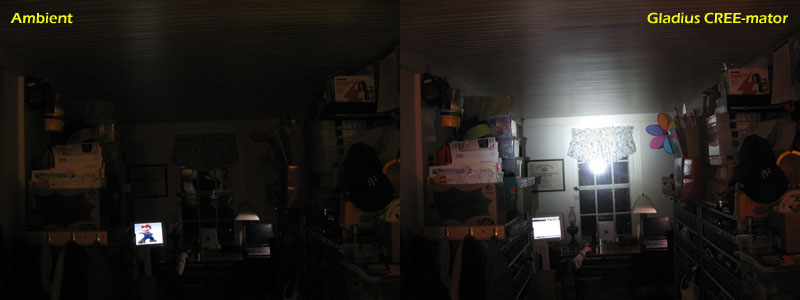
I asked another of my sons to hide in the stairwell. (Range from camera roughly 10 feet.) Quite a scary potential assailant! The value of the flashlight in this case is pretty stark...

Bottom line here: the Gladius CREEmator upgrade does indeed seem to infuse the venerable Gladius flashlight with new life, and does so while retaining the essence that makes the Gladius a great light in the first place. Construction and thermal performance are both arguably more robust than any prior incarnation of this particular flashlight. On a personal note, this has finally become a light I've been happy to use, actually reaching for it without thinking. That hadn't been the case for me in a long time.
...and Strategos let me keep the Gladius CREEmator prototype light at no charge! Only cost me my autumn to get it.
Errata
* It appears that Strategos has posted a Gladius CREEmator upgrade page over here on their website. They didn't tell me as much and for all I know, it's not even the best place to go on their website... but it's what I found after some poking around and I share it with those interested... perhaps it will save someone a little time.
* Some CPFers apparently noticed the existence of the Gladius CREEmator upgrade and speculated on its origins over here.
But I sold my Gladius a long while back, even the nifty tricked-out 'Gladiator' version I'd built for myself with stainless combat bezel and a Luxeon K2-TFFC behind a custom-cut McR27-L reflector. Here's a photo to reminisce:

Then the phone rang one fateful day earlier this year. The caller ID said, STRATEGOS INTER. What had I done wrong now!?! Market research firm conducting a survey? (Wasn't I on the do not call list?) Forgot to pay my taxes? Federal agents outside my door, about to burst in and arrest me??
:sweat:
Fortunately, reason got the better of me and I did in fact answer the phone.
What ensued consumed a good chunk of my autumn, for which I'm not complaining in the slightest! I took on a fun project with very satisfying results, and most importantly, I was able to breathe new life into what by all rights is a particularly well-designed light. (Incidentally, Strategos Intl. is, according to my understanding of the history, the co-creator of the original Gladius.)
First off: the upgraded Gladius bears the name Gladius CREEmator. I lent my Creemator name to Strategos per their request. Personally, I would have liked to call it something like Mutant Death Ray but for some reason the marketing folks over at Strategos were looking a little less over-the-top.
Profile on the Latest High-Tech Milky Photography Scaffolding

Some CPFers (such as over here) had speculated that a Milkyspit light bearing the CREEmator name must contain an XR-E; that was true when the Creemator was first introduced, as the XR-E was the only high performance Cree available at the time... but is no longer the case, as the XP-E and XP-G, among others, offer additional design options.
Moving Toward the Business End

The Gladius as a platform presented some design challenges. First, the upgrade needs to be robust, especially in light of the target market of largely professional law enforcement, search and rescue, military, private security contractors, and similar users. These lights will most definitely NOT be shelf queens.

The stock Gladius serrves the professional crowd with subtle touches like a ridiculously thick, AR coated float glass lens. I didn't take a measurement but it stood out to me that this lens is quite possibly the thickest I've ever seen on a light this size... and just in case that's not tough enough, the whole thing sits in a protective sleeve of nylon, form-fit snugly around the glass, to cushion impacts and prevent chips around the edges.
Stock Lens with Blue-Purple AR Coating Visible

For the same reasons, I designed around a reflowed XP-G on large format MCPCB and sourced a very high grade ceramic-impregnated thermal transfer tape for use in the Gladius CREEmator. That ensures that even if one shattered the lens to the point that it fell completely out of the light, the LED would remain firmly attached to its thermal path. The stack is rated to 50-G, and if one's flashlight is subjected to that degree of G-force, one's life will have long since ended, making the flashlight itself somewhat redundant.
Business End Showing the Optic Beneath Stock Lens

Beyond that, I wanted to improve on the stock light's thermal performance. The previous, Seoul P4-based upgrade tended to pool a lot of heat under the LED, and it's not uncommon to see a Seoul P4 in these lights looking downright abused. That reduces output and may change the tint of the beam as well. Fortunately, I was able to bolster the thermal path in a number of ways. The upgraded light features not only a significantly improved thermal path, but also a much larger capacity for absorbing heat internally, which ought to help matters when operating the light in a less than ideal environment.
The 'Hole' Is an Optical Illusion. The Optic is Actually Solid.

Then there's the beam itself. It would have been fairly easy to design a bright, floody light, but Strategos and their customers were looking for something with much greater punch in the beam's center, accompanied by just enough of a spill beam for a decent context, especially in close quarters use. Toward that end, I employed a largish, 26.5mm optic having beam angle of roughly 8.6 degrees. This compares favorably with the stock light's beam angle of (going from memory) 12 degrees.
Gladius CREEmator Beam Profile

I opted for Cree XP-G over the XP-E, despite the latter's ability to focus more tightly, in the interest of delivering additional lumens as well as greater overall efficiency in terms of lumens per watt. As more brightly binned XP-G enter the marketplace (which I fully expect will happen over the next several months) the XP-G's advantages will only increase. The resulting light delivers a nice performance boost over its predecessors...
Stock Gladius: 60-90 lumens, 1640 lux at 1m
Gladius with Seoul P4: 120-160 lumens, 4280 lux at 1m
Gladius CREEmator (Cree XP-G): 275+ lumens, 8790 lux at 1m
Runtimes are nearly identical with all the above lights. If anything, the XP-G upgrade will slightly increase runtime as the lower Vf of a typical XP-G will result in slightly lower current draw from the cells.
Macro Photo: Camera Face Reflected in Lens! Note Rectangular Stripes Of the XP-G Die at Center

While prototyping, I also created a reflectored equivalent to the above light, but for a variety of reasons, the reflectored design was dropped in favor of the optic. I think that was a good call on Strategos' part. That said, I include the reflectored prototype in the comparison photos that follow in the interest of completeness.
Test #1: Outdoors on a dark night, range approximately 40 yards to the target.

Test #2: Peering into an unfinished basement, distance approximately 15 feet.

Test #3: Shining across a study into the far right corner, distance approximately 12 feet.

In all the above test scenarios, the reflectored Gladius CREEmator tended to perform about as well as the older, Seoul P4 Gladius upgrade, despite bringing additional lumens to the table. (The added lumens are most noticeable in the sidespill.) The Gladius CREEmator with optic (the design adopted for production) shows a clear advantage in range while still delivering plenty of usable sidespill, even at the closer distances.
If you're read to this point, THANK YOU! :bow: :bow: I realize this is a fairly long writeup. As to the light itself, seems to this point that we're doing well. I did, however, have one lingering question: just how would the upgrade perform in more real world use rather than static comparison tests? Toward that end, I tried shining the light around the house, running the risk of alienating my wife and children in the process. I wanted to see how much of a difference the Gladius CREEmator would make in quickly identifying a person tucked away in the scene.
Shining across the Milky Lab (roughly 20 feet), one of my sons is visible even in ambient light, using the computer at the lower left of the frame. (Note the tiny hand on the mouse just to the left of the Macintosh G4 Cube computer.) Even so, the light made identification both trivially easy and much quicker, despite aiming the light at the window valence toward the top of the frame...

I asked another of my sons to hide in the stairwell. (Range from camera roughly 10 feet.) Quite a scary potential assailant! The value of the flashlight in this case is pretty stark...

Bottom line here: the Gladius CREEmator upgrade does indeed seem to infuse the venerable Gladius flashlight with new life, and does so while retaining the essence that makes the Gladius a great light in the first place. Construction and thermal performance are both arguably more robust than any prior incarnation of this particular flashlight. On a personal note, this has finally become a light I've been happy to use, actually reaching for it without thinking. That hadn't been the case for me in a long time.
...and Strategos let me keep the Gladius CREEmator prototype light at no charge! Only cost me my autumn to get it.

Errata
* It appears that Strategos has posted a Gladius CREEmator upgrade page over here on their website. They didn't tell me as much and for all I know, it's not even the best place to go on their website... but it's what I found after some poking around and I share it with those interested... perhaps it will save someone a little time.
* Some CPFers apparently noticed the existence of the Gladius CREEmator upgrade and speculated on its origins over here.

